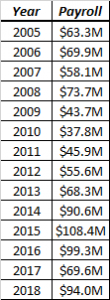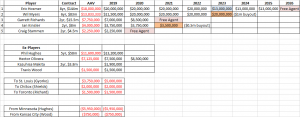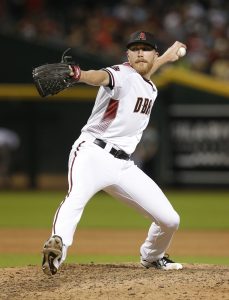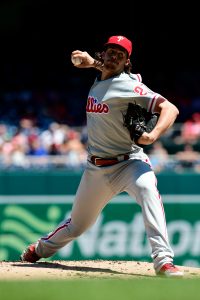As we still continue to wait for the new homes of Bryce Harper and Manny Machado, let’s move on to the 14th team payroll projection. Below find the links to the earlier posts in this series.
Philadelphia Phillies
Los Angeles Dodgers
Los Angeles Angels
Atlanta Braves
New York Yankees
Chicago White Sox
Boston Red Sox
Minnesota Twins
Milwaukee Brewers
San Francisco Giants
St. Louis Cardinals
Chicago Cubs
New York Mets
If you have questions about financial information made available to the public and the assumptions used in this series, please refer to the Phillies piece linked above.
Today, we look into a club whose rebuild has yielded one of baseball’s top farm systems: the San Diego Padres.
Team Leadership
In the realm of sports franchise ownership, the Padres got off to a rough start. C. Arnholdt Smith founded the team in 1969, but when software executive John Moores bought the team in 1994, he became the fourth distinct owner in just a 25-year span, an unseemly rate of turnover for the club. Moores held the club as majority owner for a significant period of time, but it wasn’t without its own upheaval: in 2009, a group led by agent Jeff Moorad purchased a significant minority stake in the Padres with the intention of completing the remaining purchase of the team in the coming years. Instead, after years of trying by Moorad, the team was sold in 2012 to an ownership group led by Ron Fowler (who now serves as chairman) and Peter Seidler (presently titled the organization’s general partner).
Since August 2014, the baseball operations department has been headed by executive vice president and general manager A.J. Preller. Preller inherited a team that had won 75 games per year from 2011-14 and in the first four years under his leadership, the team went on to win just 70 per year. Nevertheless, Preller received an extension in October 2017 due in large part to his efforts building a successful farm system.
The team is yet to make a postseason run under Preller (or Fowler/Seidler, for that matter), but to be fair, they won just one playoff game in the 14 years prior to the 2012 sale.
Historical Payrolls
Before hitting the numbers, please recall that we use data from Cot’s Baseball Contracts, we’ll use average annual value (“AAV”) on historical deals but actual cash for 2019 and beyond, and deferrals will be reflected where appropriate. And, of course, the value of examining historical payrolls is twofold: they show us either what type of payroll a team’s market can support or how significantly a given ownership group is willing to spend. In the most useful cases, they show us both. We’ll focus on a 15-year span for the Padres, covering 2005-18 for historical data as a means to understanding year 15: 2019. This period covers the transition from Moores to Fowler and Seidler’s ownership and includes Preller’s first attempt to buy a winner, so this provides an excellent window into what to expect from the club as they rev up to contend again. We’ll also use Opening Day payrolls as those better approximate expected spending by ownership.
Although the Padres have never been a top spender among Major League clubs, payroll underwent a meteoric rise during the first few years under new ownership, nearly tripling from 2010 to 2015 before tumbling again when Preller’s first attempt at constructing a winner backfired.
The Padres have never come remotely close to incurring a luxury tax bill, oftentimes ending with a payroll $100 million under the tax line. However, the team became a major spender on international amateur talent prior to the new system clamping down on substantial expenditures in that space, giving out the following bonuses in the 2016 class alone: $11 million to Cuban lefty Adrian Morejon, $4 million to Dominican shortstop Luis Almanzar, $3 million to Cuban righty Michel Baez, and at least five other bonuses between $1 million and $2 million each. Despite the paltry annual Major League payrolls and the smaller media market when compared to the behemoths of baseball, the Padres under Preller approached the international amateur space like the Yankees, Red Sox, Dodgers, and Cubs until a new Collective Bargaining Agreement closed that door. A major chunk of franchise spending was embedded here.
Future Liabilities
The Padres sheet is really interesting. Let’s take a look and then examine the numbers.
Let’s look at this one backward, from the bottom to the top.
The Padres have a significant chunk of their 2019 spending tied up in players who won’t be wearing Padres uniforms this year. Hughes appears to be the biggest number at first glance, but thanks to the contribution from the Twins, San Diego owes him just $7.25 million. More importantly, the purpose of that deal wasn’t Hughes: it was San Diego’s ability to draft and sign Texas Tech oufielder Grant Little with the 74th pick in the 2018 draft, acquired from the Twins alongside Hughes.
The largest commitment belongs to Hector Olivera at $16 million over the next two years. Signed by the Dodgers, Olivera was traded to the Braves, suspended for domestic violence, and then the Padres acquired his contract when offloading Matt Kemp’s remaining deal to Atlanta.
Makita failed as a bullpen import last year, while Wood failed as a trade import in 2017, leaving 2018 dead money and the buyout of his 2019 option that was split with Kansas City. Neither amount is significant.
Finally, Gyorko, Shields, and Richard also won’t play for the Padres in 2019. For Gyorko and Shields, this year represents the final year of multi-year payouts of bad decisions. For Richard, San Diego caught a break when Toronto claimed him off of waivers and agreed to take on half of his $3 million guarantee for 2019.
Add it all up and the net dead money on the San Diego books is $25.9 million in 2019, $8.5 million in 2020, and nothing beyond. Keep this in mind.
Small, short-term commitments to Kinsler and Stammen don’t move the needle much, though both figure to get a chance to play meaningful roles for the team in 2019.
Richards, on the other hand, gets yet another chance to show that he can get and stay healthy over the course of a southern California season, this time with the Padres instead of the Angels. That chance, of course, will come in 2020 after Richards underwent Tommy John surgery in July 2018.
Finally, we hit the two big numbers: Myers and Hosmer. Myers showed tremendous promise early in his career with the Rays and he excelled with San Diego in 2016, totaling 28 homers and steals while getting on base well. Unfortunately, nagging wrist injuries an an inexplicable experiment at third base have hampered his overall value in recent years. Just 28, Myers still has time to re-emerge even if the early returns on his extension have been poor. Add it all up and he has $72.5 million remaining over the next four guaranteed years, including his 2023 buyout. Not good. But not crippling.
Hosmer, similarly, provided terrible early returns on his big deal. He comically has an average WAR in even-numbered years of -0.4 compared to 2.9 in odd-numbered years, including 3.6 over his non-rookie odd-numbered years. I’m not here to stump for the even-year/odd-year split, but Hosmer has shown a trend. The Padres will surely hope to see a massive rebound from their marquee investment in 2019. Like Myers, Hosmer is still in his 20s (29). Hosmer is due $80 million over the next four years before he decides whether to hit free agency in advance of his age-33 season or keep his three-year, $39 million golden parachute.
The Padres arbitration table is arguably the leanest one we’ve seen thus far in the series:
Despite being 5’10” and nearly 32 years old, Yates figures to occupy a key role in 2019 coming off of a stellar 2018 that saw peak production and a repeat of his 2017 velocity jump. Yates figures to play an important role for the team, either as the closer or as this year’s Brad Hand, fetching a sizable return in July.
Hedges is an excellent defensive catcher and provided offense around the league average for his position last year.
Erlin excelled in a swing role in 2018 returning from Tommy John surgery, coming in under one walk per nine innings while setting career highs in velocity on every pitch. He’s worth keeping an eye on in 2019.
The remaining names — Jankowski, Mitchell, and Garcia — simply don’t move the needle much (unless the needle is moved by pure speed, in which case Jankowski moves it a ton).
What Does Team Leadership Have to Say?
At a time when most franchises are talking about payroll efficiency and ducking the luxury tax, Preller’s end-of-season comments were a breath of fresh air. In looking to 2019, Preller stated that “I feel like we’re going to have some financial flexibility, because a lot of the players are younger players. And we’re at that point from a plan standpoint where we’re going to have to supplement from the outside — be it the free agent or trade route. We’ll look to do that in the next few months.”
Fowler and Seidler, on the other hand, made waves this offseason by opening the team’s books to the San Diego Union-Tribune and revealing that they are (i) primarily focused on reducing the team’s debt load, and (ii) still hung up on the inefficient use of cash from 2015. Fowler mentioned that 2015’s $40 million payroll bump yielded just $15 million in additional ticket/concession/merchandise revenue, continuing that “It really convicted me…We had a blip in terms of revenue…(and) we dug a big hole for ourselves.”
That does not sound like an ownership group interested in spending big dollars anytime soon.
Are the Padres a Player for Bryce Harper or Manny Machado?
Yes. Definitely. Or at least they definitely should be.
The Padres don’t immediately make oodles of sense as a player at the top of the market, but they check off every other box for being a team that pursues one of these elite talents.
First and foremost, ownership has shown the penchant to spend on a winner as Preller’s 2015 experiment showed.
Second, ownership has shown a penchant to spend on “the right player” as last year’s massive deal for Hosmer showed.
Third, the Padres have a window of contention that will blow open in the next year or two.
Fourth, thanks to shrewd trades and superb drafting and development, that contender will be fueled almost entirely by players making the league minimum. The Padres have assembled one of the truly great collections of farm talent in the modern history of the game. I could go into great detail here, but instead, I’ll let the introduction to the club’s top prospect list over at Baseball Prospectus do the talking: “their full-slot, top-ten first-round pick from this year’s draft is ranked 12th overall.” If you have any interest in prospect accumulation, take a look at the Padres system and how it was built.
Fifth, they have southern California geography on their side with both a pleasing climate and proximity to Harper’s home in Las Vegas.
Sixth, they have a desperate need for an impact bat (or two) and the two spots that make the most sense for housing this bat are (i) outfield, and (ii) shortstop or third base (wherever stud infielder Fernando Tatis Jr. isn’t playing).
Seventh, outside of Hosmer and Myers, the Padres don’t have any major salaries on the books and their current Major League players heading into arbitration in the next few years won’t receive substantial awards. There simply isn’t much in the way of earmarked money going forward, be it currently guaranteed or coming through arbitration.
Eighth, the immediate payoff could be significant as the Rockies stood pat this winter aside from Daniel Murphy, the Diamondbacks kicked off a rebuild, and the Giants have thus far made modest additions.
Considering the above factors and the glacial pace of the Harper/Machado market to date, it should come as no surprise that the Padres began openly poking around the market for the superstars last week.
What Will the 2019 Payroll Be?
At this stage in the offseason, payroll is quite low at $87.6 million. This would represent a 6.8 percent drop in payroll from 2018’s Opening Day payroll. As a reminder, 2018’s Opening Day payroll was 5.3 percent below 2016’s opening day payroll. And 2016’s Opening Day payroll was 8.4 percent below 2015’s. Add it all up and this year’s Opening Day payroll would be 19.2 percent below 2015’s high water mark. In the estimate of Forbes, the franchise’s value has increased over 29.9 percent during that time.
So is this it? Is this the new normal for the Padres, same as the old normal?
Something doesn’t add up to me. The Padres sported a payroll north of $100 million in 2015 and spent nearly $100 million in 2016 while spending about $25 million on international amateurs, all while saddled with a much more notable debt burden.
There’s a scenario in play where the organization truly doesn’t want to spend, thus keeping payroll at its current level below $90 million and saving cash for…well, I’m not sure exactly. But that doesn’t line up with recent practice. The club lacks major commitments going forward and needs a big boost with a front office and ownership group that has shown a willingness to make a splash. I bet Fowler and Seidler authorize another big swing.
Keep in mind that the numbers projected below would still be below 2015 and 2016 aggregate spending levels…and that the team sees more than $20 million in dead money drop off of its books next year.
Projected 2019 Payroll: $115 million
Projected 2019 Payroll Space: $27.4 million





